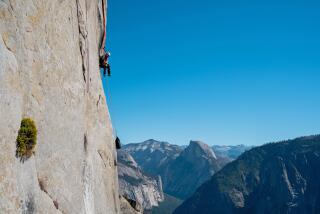Rise of the rock clones
As fielding posson approaches the Feather, a notoriously hard bouldering route at Hueco Tanks State Park in Texas, he visualizes the sequence of moves, imagining each foothold, hand pocket and ridiculous undercling.
Then he mounts, climbing quickly and fluidly, powering out from the deep hollow at the boulder’s base, to the massive bulge with its slopey pockets, and up to the head wall, with its fossil-like feather pattern. Finally, he tops out 12 feet above the crash pads at Austin Rock Gym in Austin, Texas.
Five hundred miles from the real thing, Posson has this faux Feather wired. The simulated rock route, which debuted four years ago, gives him and other Austin climbers a taste of a natural rock icon without a plane ticket or a leg-numbing all-night drive.
“The movement is definitely the same as the Feather,” says Clayton Reagan, an Austin-based climber who has done the real Hueco problem climb many times. The rock gym version, he adds, “is easier, but it’s still difficult.”
A climbing gym in Boulder, Colo., has taken rock simulation further afield. The Spot replicates the geology of famed climbing areas from Hueco to Yosemite to France’s Fontainebleau. The gym lets climbers come out of the cold or finger-searing heat and enjoy ideal climbing conditions year-round. In a society primed for convenience, mock rock is emerging as an alternative to, if not a substitute for, Mother Nature. Climbers don’t always have the spare time or funds to get to the wilds where the most sought-after rocks hide. And then there is the sheer difficulty of routes like the Feather.
Most boulderers would take one look at the gnarly syenite, overhanging with veiny protrusions, and walk away. In the controlled environment of a gym, it may seem more doable.
Yet, like other attempts to put a roof over outdoor activities — wave machines, ski runs in malls — some things get lost in translation. Climbing in a simulated environment can create a false sense of security, minus the crumbly handholds and unpredictable conditions of nature. And bringing the outdoors indoors undercuts the wild experience at the heart of the sport.
As Reagan puts it, you lose “the grass, the sky, your dog, beer, the river, no rules, the freedom of being in nature and not being confined by walls.”
But there’s no arguing with convenience. If you can’t get to the mountain, why not bring the mountain to you?
“I love Hueco Tanks, but it’s a 12-hour drive for me,” says Boulder-based Ty Foose, president and artistic director of Monolithic Sculptures Inc., one of the country’s top facsimile-rock manufacturers. “If I can’t get there, I can go to the Spot [which features Monolithic’s creations] and experience Hueco Tanks for lunch. I can get a realistic experience without having to leave town.”
Rock legend Lynn Hill, who lives in Boulder and has climbed at all of the regions replicated at the Spot, says the Boulder gym — and features like the Austin Feather — represent a fledgling trend, as some deep-pocketed owners and farsighted rock-trepreneurs begin to shift from plywood-paneled, hard-angled surfaces to textured and curvaceous structures simulating the real McCoy.
Soon enough, Hill predicts, climbers around the country will have the option of experiencing extremely realistic knockoffs in the comfort of an indoor environment — something she has mixed feelings about.
A longtime pro who has climbed some of the world’s toughest big walls (she is still the only climber to free ascend El Capitan’s the Nose in one day, which she did in 1994), Hill enjoys indoor climbing — in fact, loves having easy access to a knockoff of Fontainebleau, one of her favorite climbing regions.
But she worries that people who spend too much time on man-made surfaces miss an essential part of the sport.
“It’s much more intense, and there’s more of a sense of adventure and discovery when you’re outside. You find new climbs — and there’s nothing like that. Indoors, somebody’s done it before you.”
A way to train
FoR the hard-core outdoor climber, faux-rock climbing is no substitute. It’s more of a training tool or alternative when you can’t get to the outback. Foose says the movement toward highly realistic rock-climbing surfaces isn’t about “besting” or replacing Mother Nature.Or is it? The simulated rock dovetails with a broader cultural shift to a world where reality and fantasy, organic and synthetic commingle. There’s a fake Paris in Las Vegas, fake “real” relationships on television, video games with fake players and these weird (some argue, wonderful) wave machines. Do we at some point blur a line between reality and artificiality at our own peril?
Futurist Derek Woodgate, whose recent book “Future Frequencies” examines the links between upcoming trends and progressive pop culture, argues that simulated environments and alternate realities are, ironically, part of the natural progression of things — humans seeking ways to push the envelope, expand boundaries, make the world more convenient and manageable.
“Simulated environments allow us to do things we couldn’t do, or things we might not do in the material or natural world,” he says. Those “artificial” tools, be they wave machines or robotic prosthetic limbs, allow people to overcome obstacles and phobias, Woodgate says.
Woodgate contends that the trend toward the fantastical and the artificial is inevitable.
“The moment that you have artificial limbs or can literally change your genetics, we change as a species,” he says. “You can’t have change in one field and not expect to have change in another, like recreation and leisure, and it isn’t saying one [the pseudo] is better than the other [the natural].”
“Somebody wants to climb Everest, they’ll climb it — but the majority will never be able to climb Everest for all sorts of reasons. But what if you could simulate some of the elements that would make it feel like you’ve overcome some of the obstacles? Why wouldn’t we want to have these alternatives?”
Despite the effort to duplicate outdoor environments, there are obvious differences on an indoor rock face. For instance, bolt-on holds — which can be small, medium or large, and of varying shapes — used for handholds or foot ledges. Nature is less accommodating, of course.
One advantage of bolt-ons is that they provide a constant variety of holds, ensuring an ever-changing number of routes and return customers. Rock gyms, unlike wild stone, have to pay their way.
Some Southern California gyms, such as Boulderdash Indoor Rock Climbing Studio in Thousand Oaks and Rockreation Sport Climbing Center in Costa Mesa and Los Angeles, offer a combination of realistic rock surfaces and bolt-on holds, an advantage over a single, replicated climb like the Feather. In nature, when a climber has finally figured out a difficult route problem, he or she moves on to bigger challenges. This may be why the Feather is only one climbing feature of many in the Austin gym.
Though simulated rock walls solve some problems, like getting to remote locations, they raise other issues. Howley points out that one risk of re-creating rock so faithfully is that it can underprepare a novice for the real world of rock.
“One of our concerns was getting people too comfortable with taking big falls,” says Dan Howley, owner of the Spot. (The Spot, which charges $10 for a single outing and $435 a year for membership, has thick crash padding throughout the gym.) Plus, Howley adds, climbers are slightly more apt to strain a muscle or pull a tendon in a gym because the plastic surfaces tend to be more comfortable — encouraging climbers to hold on longer. “The plastic kind of holds onto you, whereas outside you might pop off more easily.”
The level of risk, of course, is the biggest difference between the safe confines of the gym and the rocks outside. You pay a higher price for higher risk, but the increased challenge is part of the attraction for top climbers like Hill. She once fell 80 feet at Styx Wall in France, with only a tree breaking her descent. Miraculously, she only dislocated her elbow. But she has lost her brother-in-law, Chuck Bludworth, and buddy Hugues Beauzile — both of whom died, 20 years apart, while climbing the south face of the Andes’ Aconcagua. Those tragedies have led Hill to broaden her career to sponsoring climbing-safety camps and consulting for artificial climbing environments. Yet pushing and overcoming the limits is part of why the outdoor climbing experience has a mystical, liberating quality for Hill.
Outside, she says, “the feeling is that you have to get it together, keep it together, make quick decisions and not panic. That’s a great feeling . Mother Nature is constantly breaking down, the rock is constantly going; there’s a constant process of erosion. I think that scares some people.”
Room for growth
Rock wall designers say they have seen a huge jump in demand in the last two years from architects, gym franchises, playground builders and schools. But less than 20% of the 500 or so climbing gyms in the U.S. have something like the high-end sculpted, nonpanel rock created by Monolithic Sculptures, which leaves plenty of room for growth in a market of an estimated 8 million climbers.Some California gyms have made the jump to textured surfaces or three- dimensional outcroppings. But none go as far as the Spot in re-creating a range of geologic styles.
The reason is simple: Premium faux rock is not cost-effective for most climbing gyms. A wall at the Spot that replicates Yosemite rock, for instance, cost $80,000. But with the competition growing among rock manufacturers — Monolithic’s rivals include Eldorado Wall Co. in Boulder, Nicros in St. Paul, Minn., and Entre Prises Climbing Walls USA in Bend, Ore., whose latest project is a simulated ice wall at a gym in Scotland — that could change soon.
Matt O’Connor of Eldorado Wall sees more potential ahead for synth-rock in the climbing gym world, which is “becoming a more recognized business. Facilities are becoming more inviting for the beginner and moderate climber and for families. Now they’re starting to look for something that sets them apart from other facilities. That may be rock-realistic-type walls. We’re starting to see it more and more.”
Yet even for Monolithic’s Foose, the imitation will always have a glaring limitation. “For me, as a long-term climber, rocks emanate a certain energy, a certain spirituality, and we can’t duplicate that. There’s something about interacting with a million-year-old formation that you just can’t re-create. And if you put a real rock inside a building, you’ve already lost half the appeal of the thing. We do the best we can to create an interesting environment, but it’s never a complete substitute for what you find outside.”
People like Woodgate, who see the broader artificial-vs.-natural debate as part of man’s evolution, maintain that replicated environments simply present more choices — not a rift between man and nature. “We are moving into a world where simulated experience is part of our reality, but that doesn’t exclude reality,” he says. We can always choose the real thing if we want it.
Outdoor fan Reagan agrees wholeheartedly — but sees a definite benefit to faux rock. “Actually, I’d prefer that all the climbers go to the gyms instead of crowding up the walls outside. I like a little serenity when I climb, and you can only find that outside.”
On real rock.
Shermakaye Bass is a freelance writer based in Austin, Texas.
More to Read
Sign up for our L.A. Times Plants newsletter
At the start of each month, get a roundup of upcoming plant-related activities and events in Southern California, along with links to tips and articles you may have missed.
You may occasionally receive promotional content from the Los Angeles Times.






